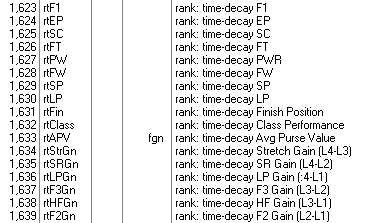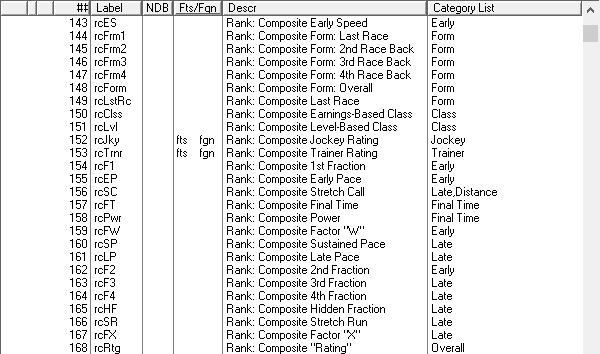-
Ziemba articleThat's the pronunciation of the two words. For instance, it is NOT log-it. — RanchWest
Hilarious!
:razz: :rofl: -
Ziemba articleThanks Dave! This is another concept that will twist my brain in x directions. LoL — William Zayonce
LOL
If you like CX Wong's book, know that there is a link in it to a whole bunch of spreadsheets.
Precision: Statistical and Mathematical Methods in Horse Racing -
Ziemba articleA bit of thread drift, but if you like that one, perhaps you will like this one as well.
SEARCHING FOR POSITIVE RETURNS AT THE TRACK: A MULTINOMIAL LOGIT MODEL FOR HANDICAPPING HORSE RACES
LOGIT is the basis for how the whales play.
Basically, there are two strategies used by the whales.
- Logit
- Probit
Which leads to this:
Logit vs Probit Models: Differences, Examples -
Gulfstream data errorsAre you guys seeing this issue with your data?
At some point Gulfstream changed races originally scheduled for Turf to be moved to the Tapeta instead of the main track. Because there has always been one symbol for "off the turf" that historically means "moved to dirt", my incoming data is showing off the turf races as ran on dirt, when they were actually moved to tapeta. — Dustin Korth
What is your data source? -
Any opinions on this practice?Ranch- I have never seen a rule prohibiting this practice. I have seen trainers requiring some sorts of kickbacks from riders but nothing like this story. Illegal no- unethical yes — Tony Kofalt
Exactly. -
Tom's Ulitmate Odds Line - The SoftwareImitation is the most sincere form of flattery. :)
I got them from Benter. ;)
Here are the time decay factors in HSH.

Here are the Composite Factors.

Take a look at Time-Decay Stretch Run and the like. -
ChaosDave has a product entitled "Understanding Early Speed".... In one of the later chapters he defines four distinct race shapes based upon "pace pressure" (using Quirin Early Speed Points).... If there is "no discernable pace pressure" or in other words, pace pressure is not predictable, then you have a "chaos" race.... This "process" has served me well and I'll leave it to Dave to elaborate if he so chooses....
Or, I'm sure he'd be pleased if you purchased this excellent product!
BTW, I'm not a shill for Dave and I must admit I've purchased most all of his products.... I've both used and discarded many of his ideas; but without exception, I've found handicapping "nuggets" in all of them! — Jack Price
Just awesome.
I just happen to have a link right here.
Understanding Early Speed -
ChaosI'm not sure if I have much to offer because, to me, "Chaos Race" means something very different than it seems to mean to you guys.
Not saying you're wrong, but to me it indicates... well, chaos. LOL
Now, I understand that in the mathematical sense, "chaos" really means that order exists where there seems to be no order.
But, my opinion is that when you find a CHAOS RACE, you (essentially) don't handicap it because the handicapping won't select the winner.
My belief being what it is, CHAOS could easily mean HANIDCAPPING WILL FAIL.
I find TWO INSTANCES that consistently produce CHAOS RACES:
- Very Low Odds Horse Loses
- Early Speed Fails
-
001-Core Programming: Why Bother to Improve Your Coding?What language are you using, Dave? — RanchWest
I use a language called Clarion.
http://www.softvelocity.com/ -
001-Core Programming: Why Bother to Improve Your Coding?I am on probably my fourth or fifth version (hopefully a final version) of my software. — Steven
There is an old saying... "Being a programmer means never having to say you are finished."
I feel your pain.I don't get away with zero documentation/notation but I am pretty much to minimum documentation/notation. I had to abandon hundreds of hours of code in order to write better code. — Steven
I had to abandon over 10,000 hours worth of working code from HSH!
(That's 2/3s of all the coding I did in of 20 years on HSH!)
I've built a strict rule:
"All new code will fit my personal 10-x Coding Standards."
I am sure you know how difficult this is - to take the CODING HIGH ROAD for everything new.
Like, I was writing a simple set of list-up/down buttons.
Imagine, you have an alpha list but you want it sorted in a LOGICAL ORDER way.
Further, you don't want the user to have to ever type in a logical order number.
In HSH, I actually used numbers, but I vowed to do better code in the Studio and going forward.
So, I bit the bullet and spent about 15 hours writing a set of functions to manage this, instead of maybe 1 hour to get it working the old way.
(If you want to know how it works, I'd be happy to show you.)
But there was a payoff.
I've now used it in about 10 different browses, and have begun to reap the returns, because it now takes about 15 minutes to facilitate adding those buttons and making them functional in any browse!
Not EVEN yet, but getting there. -
001-Core Programming: Why Bother to Improve Your Coding?
WONDERFUL POST!
Have you been reading this book?
Clean Code: A Handbook of Agile Software Craftsmanship -
TicketmakerI can't speak for Tony, but as someone who has built ABC tickets, I suspect it would benefit Tony to have multiple calculators.
AB/ABC/ABC
A/ABC/C
C/AB/ABC
That sort of thing. — RanchWest
Actually building that in The Studio part today. -
Ticketmaker
Please, tell me what can be improved because I want to build a ticket writer into the new software -
TicketmakerI cannot seem to download as a exe (I changed the file to exe) but it says I cannot open due to being a Microsoft file on a Apple — Conley
That's correct.
It is a Windows app.
Dave Schwartz

Start FollowingSend a Message

